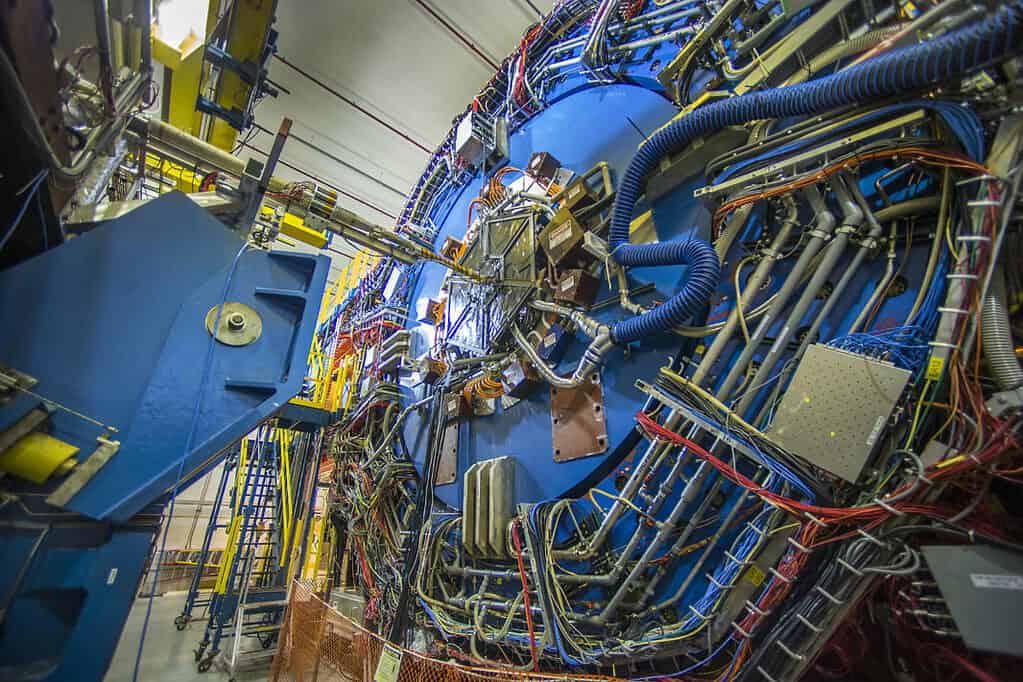
For the first time, physicists at the Brookhaven National Laboratory have come across a novel type of quantum entanglement, the extremely bizarre phenomenon that occurs when a pair of particles remain connected even when separated by galactic distances. Thanks to this effect, the researchers were also able to peer inside the atomic nuclei with unprecedented detail.
A new kind of quantum entanglement
Quantum entanglement is a strange and fascinating phenomenon that has puzzled scientists for decades. It occurs when pairs of particles become so closely connected that one can no longer be described without the other, no matter how far apart they may be. Even more strange, changing one will instantly trigger a change in its partner, even if it was on the other side of the universe. In theory, this effect would enable faster-than-light communication if you encode the changes in these states with 1s and 0s.
This concept may sound impossible to us, as it goes against our classical understanding of physics, and it even unnerved Albert Einstein, who referred to it as “spooky action at a distance.” However, numerous experiments have consistently proven the existence of quantum entanglement by manipulating the properties of the entangled particles, such as their spin or polarization, and observing the effects on the other particle. Today, quantum entanglement forms the backbone of emerging technologies such as quantum computers and networks.
Traditionally, observations of quantum entanglement have been made between pairs of photons or electrons that are identical in nature. Recently, however, physicists at Brookhaven National Laboratory (BNL) in New York made a significant breakthrough: they have discovered a new kind of quantum entanglement involving pairs of dissimilar particles. This groundbreaking discovery was made using the Relativistic Heavy Ion Collider (RHIC) at BNL, a facility that can accelerate charged atoms, known as ions, to nearly the speed of light. When these ions collide or pass near each other, their interactions reveal the inner workings of atoms, which are governed by the bizarre laws of quantum mechanics.
Peering into the heart of atoms
The BNL team made their discovery by studying gold ions that were accelerated to almost the speed of light. These ions were surrounded by clouds of photons, and when the ions passed near each other, the photons interacted with another type of particle called gluons, which hold atomic nuclei together. These interactions resulted in the creation of two new particles called pions, which have opposite charges – one positive and one negative. When these pions struck the RHIC detector, the instrument measured some of their key properties, such as velocity and angle of impact, which were then used to probe the size, shape, and arrangement of gluons within the atomic nuclei with an unprecedented level of precision.
“We measure two outgoing particles and clearly their charges are different — they are different particles — but we see interference patterns that indicate these particles are entangled, or in sync with one another, even though they are distinguishable particles,” said Brookhaven physicist and STAR collaborator Zhangbu Xu.
This is a major achievement because scientists have previously imaged atomic nuclei at lower energies, but attempts to probe these structures at high energies have always produced confusing results. In these experiments, nuclei appear much larger than expected according to models, a mystery that has puzzled scientists for years. However, the BNL team has now solved this puzzle by identifying a blurring effect that is linked to the strange behavior of gluons within atomic nuclei. This blurring effect has caused nuclei to appear larger than expected in previous experiments, but the team’s new findings reveal that gluons are actually much more spread out than previously thought, which explains the discrepancy.
This remarkable discovery has given us a new window into the mysterious world of atoms, and it could have significant implications for a variety of fields, including quantum computing and astrophysics. It could also lead to the development of new technologies, such as the method used by the team to study the nucleus of gold ions. Furthermore, this discovery expands our understanding of quantum physics and the strange phenomena that occur at the atomic level.
“We’ve never seen interference between distinguishable particles before,” Daniel Brandenburg, a physics professor at Ohio State University who co-authored the study told VICE. “That’s the discovery; the application is that we get to use it to do some nuclear physics.”
While this groundbreaking discovery was a surprise to the team, it highlights the incredible potential of quantum entanglement and the mysteries that it could help us to uncover. Who knows what other strange and unimaginable phenomena may be waiting to be discovered in the vast and mysterious universe we live in? One thing is certain: the study of quantum entanglement will continue to captivate and intrigue scientists and laypeople alike as we strive to unlock the secrets of the cosmos.
The new findings appeared in the journal Science Advances.









